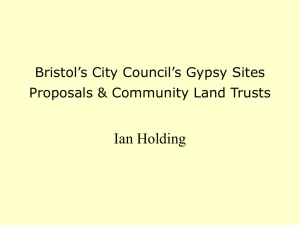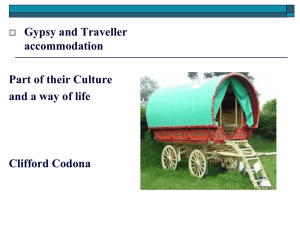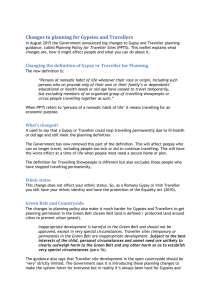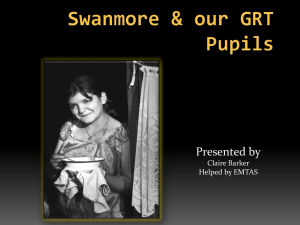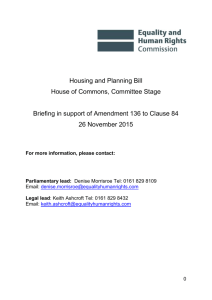Draft Revised GTAA (January 2016)
advertisement
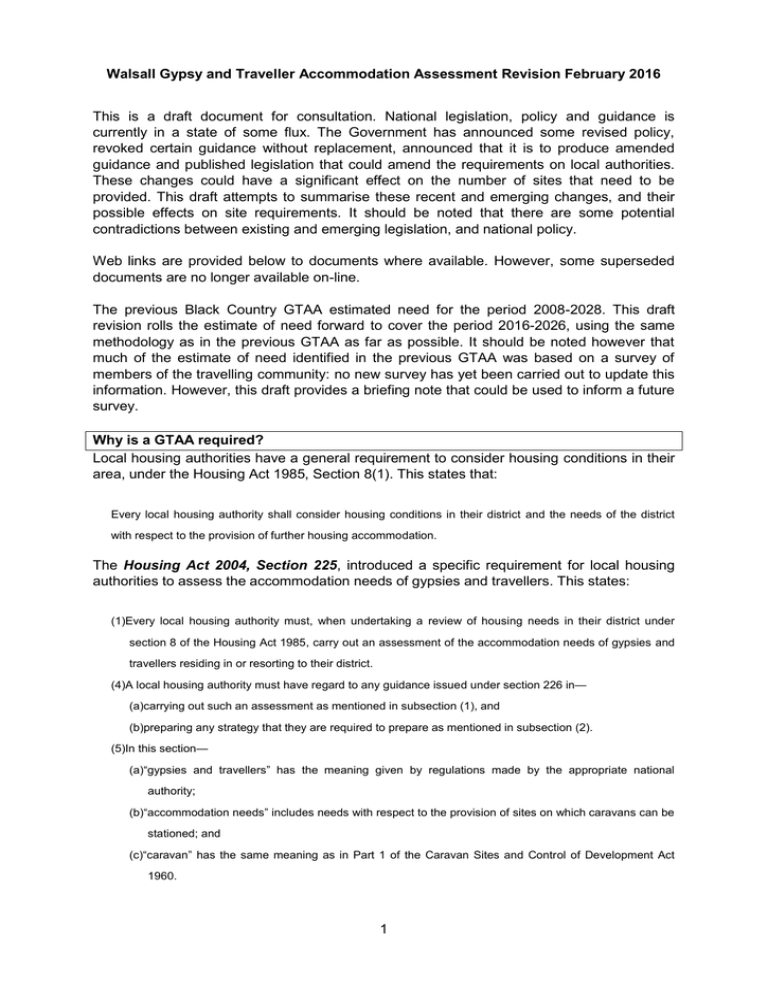
Walsall Gypsy and Traveller Accommodation Assessment Revision February 2016 This is a draft document for consultation. National legislation, policy and guidance is currently in a state of some flux. The Government has announced some revised policy, revoked certain guidance without replacement, announced that it is to produce amended guidance and published legislation that could amend the requirements on local authorities. These changes could have a significant effect on the number of sites that need to be provided. This draft attempts to summarise these recent and emerging changes, and their possible effects on site requirements. It should be noted that there are some potential contradictions between existing and emerging legislation, and national policy. Web links are provided below to documents where available. However, some superseded documents are no longer available on-line. The previous Black Country GTAA estimated need for the period 2008-2028. This draft revision rolls the estimate of need forward to cover the period 2016-2026, using the same methodology as in the previous GTAA as far as possible. It should be noted however that much of the estimate of need identified in the previous GTAA was based on a survey of members of the travelling community: no new survey has yet been carried out to update this information. However, this draft provides a briefing note that could be used to inform a future survey. Why is a GTAA required? Local housing authorities have a general requirement to consider housing conditions in their area, under the Housing Act 1985, Section 8(1). This states that: Every local housing authority shall consider housing conditions in their district and the needs of the district with respect to the provision of further housing accommodation. The Housing Act 2004, Section 225, introduced a specific requirement for local housing authorities to assess the accommodation needs of gypsies and travellers. This states: (1)Every local housing authority must, when undertaking a review of housing needs in their district under section 8 of the Housing Act 1985, carry out an assessment of the accommodation needs of gypsies and travellers residing in or resorting to their district. (4)A local housing authority must have regard to any guidance issued under section 226 in— (a)carrying out such an assessment as mentioned in subsection (1), and (b)preparing any strategy that they are required to prepare as mentioned in subsection (2). (5)In this section— (a)“gypsies and travellers” has the meaning given by regulations made by the appropriate national authority; (b)“accommodation needs” includes needs with respect to the provision of sites on which caravans can be stationed; and (c)“caravan” has the same meaning as in Part 1 of the Caravan Sites and Control of Development Act 1960. 1 “Gypsies and Travellers” are defined in law in The Housing (Assessment of Accommodation Needs) (Meaning of Gypsies and Travellers) (England) Regulations 2006 (SI 2006/3190) as follows: 2. For the purposes of section 225 of the Housing Act 2004 (duties of local housing authorities: accommodation needs of gypsies and travellers) “gypsies and travellers” means— (a) persons with a cultural tradition of nomadism or of living in a caravan; and (b) all other persons of a nomadic habit of life, whatever their race or origin, including— (i) such persons who, on grounds only of their own or their family’s or dependant’s educational or health needs or old age, have ceased to travel temporarily or permanently; and (ii) members of an organised group of travelling showpeople or circus people (whether or not travelling together as such). This definition should be compared with that in the Planning Policy for Traveller Sites, both the original March 2012 version and the August 2015 version as below. How should the assessment be carried out? Government guidance is currently contained in: Gypsy and Traveller Accommodation Needs Assessments Guidance October 2007 https://www.gov.uk/government/publications/gypsy-and-traveller-accommodation-needsassessments This guidance was prepared under ODPM Circular 1/2006 which was replaced in 2012 by the Planning Policy for Traveller Sites. The current Government proposes to revoke and replace this guidance (see below). Some elements of the 2007 guidance refer to other national policy and guidance that has already been superseded. Key paragraphs of the 2007 guidance state as follows: 1. A Gypsy and Traveller Accommodation Needs Assessment will be required either as part of a Strategic Housing Market Assessment in respect of the local community generally, or separately where a Strategic Housing Market Assessment is not being conducted at that time. What is ‘accommodation need’ for Gypsies and Travellers? 14. In Planning Policy Statement 3 [PPS3], housing need is defined as ‘the quantity of housing required for households who are unable to access suitable housing without financial assistance’ and housing demand ‘the quantity of housing that households are willing and able to buy or rent’. 15. In many cases, this definition will also be appropriate for Gypsies and Travellers, particularly those living in bricks and mortar housing. However, the distinctive accommodation requirements of some Gypsies and Travellers will give rise to similar types of need, but in a different context, for example: Caravan dwelling households: • who have no authorised site anywhere on which to reside; • whose existing site accommodation is overcrowded or unsuitable, but who are unable to obtain larger or more suitable accommodation; 2 • who contain suppressed households who are unable to set up separate family units and who are unable to access a place on an authorised site, or obtain or afford land to develop one. Bricks and mortar dwelling households: • whose existing accommodation is overcrowded or unsuitable (‘unsuitable’ in this context can include unsuitability by virtue of proven psychological aversion to bricks and mortar accommodation). Whom does the Gypsy and Traveller Accommodation Needs Assessment cover? 23. The definition of ‘gypsies and travellers’ for this purpose is specified in ‘The Housing (Assessment of Accommodation Needs) (Meaning of Gypsies and Travellers) (England) Regulations 2006 ’. 29. The inclusion of someone within a survey as a ‘Gypsy’, ‘Traveller’, ‘New Traveller’ or ‘Travelling Showman’, within the definition set out above, does not in itself imply that that person ‘should’ live on a site, or that they have ‘gypsy status’ for planning purposes, nor does it carry any presumption about how identified needs should be met. Gypsy and Traveller accommodation needs may be met in a variety of ways, including: • standard owner-occupied bricks and mortar housing; • affordable housing, or group lets of affordable housing; • provision of group housing (small groups of purpose-built bungalows designated for use by Gypsies and Travellers); • socially rented site accommodation of various kinds; privately rented site accommodation; • Gypsies’ and Travellers’ own provision of authorised accommodation providing legal and licensed sites on their own land. Responsibility for the process 39. The Accommodation Needs Assessment process should be led by the local authority housing department working closely together with the planning department. Those responsible should have suitable seniority to take ownership of the outcome and ensure that policies are adopted across the local authority as a whole. Carrying out the assessment 55. It may be sensible for different groups to be involved at different times – for example, in-house staff analysing the existing data, and specialists being brought in to do more detailed assessments. 56. In reaching a decision on the way forward, a local authority or partnership will wish to consider: • the capacity and expertise of in-house staff; • the qualifications and track record of consultants; • how effective each option might be in reaching the target group (e.g. whether in house staff are also responsible for enforcement action, and hence might be seen negatively by Gypsies and Travellers, or 3 whether the use of Gypsies and Travellers themselves may be helpful in obtaining access to the community and secure the trust of those being assessed); • the perceived independence of the process, which will be vital for securing public acceptance of the results; • the credibility of each option with both Gypsies and Travellers and the settled community; • costs. 60. The assessment itself is likely to have two separate components: • an analysis of existing data sources; • conducting a specialist survey. Existing data sources Gypsy and Traveller caravan count local authority site management records. These may provide information about site licensee households, pitch turnover or length of licences, site waiting lists and transfer applications and movement between site accommodation and bricks and mortar housing or vice versa; information relating to private authorised sites should include the number of caravans permitted on each site, whether the planning permission was granted on a permanent or temporary basis, and whether it restricted occupancy to named individuals data on unauthorised encampments and unauthorised developments Conducting a specialist survey The survey will need to cover a sufficiently representative sample of each type of site accommodation existing in the local authority Timing of the survey 81. Careful consideration should be given to the appropriate timing for the survey. The caravan count consistently shows higher numbers on unauthorised encampments, and lower numbers on permanent residential sites, in the summer. It is likely that numbers in housing will also be lower in the summer. Future Need 92. Accurate projections of future needs are likely to be more difficult. Current levels of satisfaction with existing accommodation will provide some indication of whether households are likely to stay in that accommodation. Analysis of changing demand (which may be expressed through unauthorised sites, or low demand for authorised sites) will provide further information. 93. Information on the likely rate of household formation and assessments of future accommodation need should be based primarily on locally gathered evidence, rather than average national estimates which may not reflect the position in the survey area concerned. Local trends should be identifiable from the current demographic profile of the community obtained from the local survey, from agencies working directly with local Gypsy and Traveller communities and from figures previously given for the caravan count. Gypsy 4 and Traveller community representatives on the steering group should also be able to advise. In the event that local data does not provide a clear picture it should be noted that average national estimates range between 3-4%. 94. In the case of Gypsies and Travellers it will probably not prove realistic to try and forecast need for up to 15 years ahead, as is recommended within the Strategic Housing Market Assessment guidance for the rest of the community. However, the most accurate projections possible covering the next 5-10 years should be made. 95. It should be possible to identify: • the intentions of those households planning to move which may free up spare pitch or bricks and mortar capacity; • the likely rate of household formation and annual population increase; • travelling patterns within the survey area and in and out of surrounding areas. The Annex to the 2007 Guidance provides advice on the possible topics to be addressed in any survey. These include general household information, intentions and preferences, and opinions about existing sites. Reference is made in paragraphs 1, 14 and 95 of the 2007 Guidance to PPS3 and the separate 2007 guidance on preparing Strategic Housing Market Assessments (SHMAs). PPS3 has been replaced by the National Planning Policy Framework whilst the SHMA guidance was replaced in 2014 by Planning Practice Guidance (PPG). Paragraph 003 of the PPG states that “Need for housing in the context of the guidance refers to the scale and mix of housing and the range of tenures that is likely to be needed in the housing market area over the plan period – and should cater for the housing demand of the area and identify the scale of housing supply necessary to meet that demand.” The distinction between housing “need” and housing “demand” in PPS3 has therefore been removed, and housing need now refers to both open market and affordable housing. This definition is closer to paragraph 29 of the GTAA guidance, which includes owner-occupied housing.] Existing Black Country GTAA The existing Black Country GTAA was prepared in 2008. Table 12.1 and the subsequent text provides a summary of how need was calculated The methodology follows the illustrative methodology set out in paragraph 96 of the 2007 guidance almost verbatim. The need identified was incorporated into the Black Country Core Strategy which was found sound at examination in 2010 and adopted in 2011. However, the GTAA only indicates the need for the period to 2018. The raw data used to produce the GTAA was not provided to the local authorities by the consultants, so it is not possible to re-interrogate this. However, the questionnaire provided to respondents was attached to the report. Many of the questions asked were about the quality of existing accommodation, but is unclear how responses have been reflected in the 5 subsequent assessment of need. At least some of the questions about likely future need appear to have been rather subjective (such as “would you like to move to a site?”) and could be said to have encouraged an affirmative response. Approximately half the need identified was from family units in housing but with a psychological aversion to housed accommodation. It would be difficult to ask a direct, objective question about this, however the questionnaire does not appear to have included even a “proxy” question about this. Recent and Emerging Changes to Legislation and Guidance Planning Policy for traveller sites March 2012 (PPTS 2012) This was introduced in parallel with the National Planning Policy Framework. It states: 8. Local planning authorities should set pitch targets for gypsies and travellers and plot targets for travelling showpeople which address the likely permanent and transit sites accommodation needs of travellers in their area. 9. Local planning authorities should, in producing their Local Plan, identify and update annually, a supply of specific deliverable sites sufficient to provide five years’ worth of sites against their locally set targets, and identify a supply of specific, developable sites or broad locations for growth, for years six to ten and, where possible, for years 11-15. 10. Criteria should be set to guide land supply allocations where there is identified need. Where there is no identified need, criteria-based policies should be included to provide as a basis for decisions in case applications nevertheless come forward. The Annex to PPTS 2012 states: 1. For the purposes of this planning policy “gypsies and travellers” means: Persons of nomadic habit of life whatever their race or origin, including such persons who on grounds only of their own or their family’s or dependants’ educational or health needs or old age have ceased to travel temporarily or permanently, but excluding members of an organised group of travelling showpeople or circus people travelling together as such. 2. For the purposes of this planning policy, “travelling showpeople” means: Members of a group organised for the purposes of holding fairs, circuses or shows (whether or not travelling together as such). This includes such persons who on the grounds of their own or their family’s or dependants’ more localised pattern of trading, educational or health needs or old age have ceased to travel temporarily or permanently, but excludes Gypsies and Travellers as defined above. Planning Policy for traveller sites August 2015 (PPTS 2015) PPTS 2012 was replaced by a new version in August 2015. The new policy is identical in most parts but omits “or permanently” from the definitions of gypsies and travellers and travelling showpeople in its annex. In addition, paragraph 25 of the 2012 policy stated that the lack of an up to date five-year supply of deliverable sites should be a significant material consideration in any subsequent planning decision when considering applications for the grant of temporary planning permission. This has been replaced by paragraph 27 of the 2015 policy which now adds that the exception is where the proposal is on land designated as Green Belt or other protected areas. Also in August 2015, the Government published “Planning and travellers: proposed changes to planning policy and guidance” https://www.gov.uk/government/consultations/planningand-travellers-proposed-changes-to-planning-policy-and-guidance . This sets out how the Government intends to proceed following a consultation carried out in 2014 on proposed 6 changes to national planning policy. As well as the revised Planning Policy, the document also states: - Primary legislation to be amended to clarify the duties of local authorities to plan for the housing needs of their residents. - The Government will lay before Parliament a proposal to revoke the 2007 GTAA guidance. Subject to that the Government will publish new guidance on traveller accommodation needs assessments. - 2008 Designing Gypsy and Traveller Sites – Good Practice Guide is revoked. In respect of the first point, Clause 91 of the Housing and Planning Bill proposes to amend section 8 of the Housing Act 1985 to include a duty for local housing authorities to: consider the needs of people residing in or resorting to their district with respect to the provision of— (a) sites on which caravans can be stationed, or (b) places on inland waterways where houseboats can be moored. And: In the Housing Act 2004 omit sections 225 and 226 (accommodation needs of gypsies and travellers). The effect of these two changes would appear to be to remove an explicit requirement to assess the accommodation needs of gypsies and travellers, but to replace it with a requirement to assess the needs of all who live (or who want to live?) in caravans (or houseboats). In comments to the Public Bill Committee on 26th November 2015, the Minister for Housing and Planning stated: http://www.publications.parliament.uk/pa/cm201516/cmpublic/housingplanning/151126/pm/1 51126s01.htm “The clause makes it clear that the needs of those persons who reside in or resort to the area with respect to the provision of caravan sites or moorings for houseboats are considered as part of the review of housing needs. That would include all those who are assessed at present and potentially those who simply choose to live in a caravan, irrespective of their cultural traditions or whether they have ever had a nomadic way of life.” “I want to reinforce and make clear the fact that this clause does not remove the requirement to assess the specific accommodation needs of Gypsies and Travellers. Local housing authorities will still need to consider their protected characteristics and cultural links to caravan dwelling.” Implications for Walsall GTAA of Recent and Emerging Legal and Policy Changes The 2008 GTAA only assesses need to 2018 and does not indicate needs for 5/10/15 years as required by the national Planning Policy. It should be extended to 2026 (equivalent to 10 years), which would be in line with the Black Country Core Strategy end period for general housing. Extending the timeframe might be expected to result in a requirement for a greater number of sites. However, the SAD currently provides an estimate of the total remaining requirement to 2026 that is lower than the BCCS figure: this is mainly because much of the need identified in the 2008 GTAA was to address an existing shortfall of suitable sites, and the 2008 GTAA used an annual household growth rate (3%) that was based on the example in the DCLG guidance rather than any rate that was appropriate for the local community. A 3% per annum household growth rate is considerably higher than that of the general population 7 of Walsall (but see comments below about the household composition of traveller households). The SAD also seeks to retain some small sites that currently have temporary or personal permissions, which has the effect of reducing the number of “new” sites needed. The 2008 GTAA made no attempt to estimate an appropriate local household growth rate. The only question from the survey that related to household growth (apart from the ages of family members) was about the likelihood of family members moving to a separate home within the next five years Since 2008, both the 2011 Census and the annual school census have recorded the numbers of gypsies and travellers. A summary of relevant figures is in the Appendix below. The numbers recorded in the schools census, even for January 2011 which is the nearest date to the main Census, are significantly higher than in the main Census. This reflects the difficulty in obtaining accurate information about traveller numbers, in part because members of the community are often reluctant to declare their origins because of the fear of discrimination. However, the Census records that average household sizes for travellers in Walsall are higher than for the general population, and the traveller community has a much higher proportion of children. These figures could indicate a high level of overcrowding and concealed households either now or in the future as traveller children grow up and wish to form separate households. There is no longer a requirement to specifically assess the needs of those who have ceased to travel permanently (however, their housing needs will still have to be assessed as part of the general housing needs assessment under Section 8 of the Housing Act 1985). It is unclear how a distinction is to be made between those who have ceased to travel permanently and those who have ceased to travel temporarily. Some GTAAs (prepared prior to the new policy) asked respondents how often they travelled: a large proportion advised that they only travelled to fairs and for family visits. The 2008 GTAA asked how often respondents had travelled in the past 12 months, but did not explore this question in any more detail (“travelling” could be interpreted as including day trips, holidays or short family visits). The Housing and Planning Bill would end the requirement to assess the housing needs of gypsies and travellers living in (and wanting to remain in) bricks and mortar. However, it could result in more of the traveller community (and members of the general population) expressing a wish to live in caravans so as to be provided with a site. Conclusions and Recommendations The 2008 GTAA was produced using a survey of travellers living both in caravans and bricks and mortar. It divided the sources of future need and potential supply into a number of elements using the methodology contained in the Government Guidance. The estimate of need stated in the SAD has been produced by a desk top exercise that updates some of these elements, using data that is known to have changed since 2008, such as new site provision. However, some recent and emerging changes since 2008 are to elements that were not clearly measured in the original GTAA. In particular, the revised Planning Policy for Traveller Sites (August 2015) means that it is now necessary to know what proportion of the community have ceased travelling permanently. Such information could only be confirmed through a new survey of the community. 8 This change, the Government’s proposal to revoke the GTAA guidance, and the proposal in the Housing and Planning Bill to limit the requirement to assess need to those who live in caravans (although there is a contradiction between the Minister’s comments to the Public Bill Committee and the current national Planning Policy: the Minister’s comment that need should be assessed “irrespective of their cultural traditions or whether they have ever had a nomadic way of life” is at odds with the Planning Policy requirement that only the needs of those who have ceased to travel temporarily should be assessed) had not been announced at the time the SAD Preferred Option was prepared. A new survey is likely to require some months, and could be premature in view of the emerging changes in legislation and guidance. It is also likely to take several months for the Housing and Planning Bill to be enacted and any revised GTAA guidance issued. In the event that the current GTAA guidance is revoked, any amended GTAA for Walsall that is prepared under it could become out of date immediately. To avoid delay to the SAD, and consequential effects on other issues such as general housing allocations and the potential review of the BCCS, it is recommended that no formal GTAA revision is attempted at this stage. As with the assessment of the need for general housing, the SAD should continue to follow the numbers required by the BCCS: this would result in a speedier allocation of at least some traveller sites. However, the table below shows the potential impact on site requirements: Change Planning Policy Statement revision to exclude those who have ceased to travel permanently from the definition of travellers for planning purposes Potential Effect Likely to reduce site requirement, but the 2008 Black Country GTAA does not record data about travelling in sufficient detail to allow a desktop update to be made. A new survey would therefore be needed. However, it is unlikely that members of the community would be willing to admit to having ceased travelling, as this would imply they are no longer eligible to have sites provided. Could indicate that future demand for sites is greater, however the census figures are unreliable given the small size of the community and the tendency to underrecord: this is why targeted surveys of the traveller community are necessary. In addition, the 2011 Census is a one-off (the 2001 Census did not record travellers), so it is not possible to use it to identify trends. Could reduce site requirement, if it excluded those wishing to move from bricks and mortar, however the ministerial comments suggest that any revision to guidance will still require the general accommodation needs of gypsies and travellers to be assessed, including those who do not at present live in caravans. More detailed information about population and household sizes available from the 2011 and schools censuses Housing and Planning Bill proposal to limit the requirement to assess need to those in caravans The table below shows the potential impact on numbers if the methodology in the 2008 GTAA was still followed. This is based on tables 12.10 and 12.11 in the GTAA which shows 9 figures for Walsall. It should be noted that several of the fields could only be updated using information from a survey. 1) Current occupied permanent/ residential site pitches Current residential supply 2) Number of unused residential pitches available 3) Number of existing pitches expected to become vacant through mortality 4) Number of family units on sites expected to leave area 5) Number of family units on sites expected to move into housing 6) Residential pitches planned to be built or to be brought back into use 7) Additional supply generated by movement within stock Total Supply Current residential need: Pitches 8) Family units (on pitches) seeking residential pitches in the area, excluding those already counted as moving due to overcrowding in step 11 9) Family units on unauthorised encampments requiring residential pitches in the area 10) Family units on unauthorised developments requiring residential pitches in the area 11) Family units currently overcrowded on pitches seeking residential pitches in the area, excluding those containing an emerging family unit 12) New family units expected to arrive from elsewhere 13) New family formations expected to arise from within existing family units on sites 13A) New family formation 2013-2026 Total Need excluding step 14) Current residential need: Housing 14) Family units in housing but with a psychological aversion to housed accommodation Total Need Balance of need and supply Total Additional Pitch Requirement 2008 GTAA Requirement 2008-2013 20 2016 Update Requirement 2016-2026 37 0 0.6 0 1.2 1.6 2.5 0 0 6.0 0 4.5 15.1 0 1.2 2.4 0 0.0 0 4.0 4.0 2.1 2.1 1.6 4.6 0 4.6 9 (2013-18) 23.7 14 (@ 3% per annum growth) 4 (@ rate used in SAD) 14.7 to 24.7 30.0 0 53.7 14.7 to 24.7 30 (plus 2013-18) 9 Between and 24 14 Notes for above table Numbers may not add precisely because of rounding of fractions. 1) The 2008 GTAA does not list the locations of the existing pitches. Six pitches at Willenhall Lane were out of use awaiting refurbishment (so are listed under step 6)), so the total number of existing pitches including unused ones would have been at least 26. However, 32 of the existing pitches in 2016 (these are listed in the SAD) are known to have existed with a 10 permanent unrestricted planning permission in 2008, so it appears that the 2008 GTAA under-recorded the number of existing pitches by about 6. The 37 pitches in 2016 include 4 at Gould Firm Lane that are the subject of a personal planning permission, but not the 4 at Cartbridge Lane as they only have a temporary permission. 2) The bi-annual caravan survey indicates that some of the 37 pitches recorded in 2016 may be unused or under-used at certain times of the year. However, they all appear to be let so are not available for new families. 3) An annualised mortality rate is used for 2016-2026 that matches that for 2008-2013. The small size of the population means that it is not possible to make an accurate estimate of this figure. 4) and 12) The 2008 GTAA (and most others) assume that in-migration will balance outmigration. This avoids the potential for double counting in assessments for adjoining areas. 5) In the absence of recent survey data, it is assumed that all families who stated in 2008 that they expected to move back into bricks and mortar within 5 years have done so. 6) Further to note 1) above, the refurbishment of Willenhall Lane has been completed. 7) The 2008 GTAA included this figure to allow for the fact that movements of families between pitches for reasons other than overcrowding (which is recorded at step 11), being on unauthorised sites (step 10) or moving into bricks and mortar (step 5) generates supply from the pitches they vacate. The 2008 figures were derived from the survey, which revealed the numbers of families who wished to move. In the absence of an up to date survey, it is assumed that all families who wished in 2008 to move have done so, so no further supply can be expected from this source. 8) Again, the absence of an up to date survey means that there is no evidence of any families already living on authorised pitches but wishing to move for reasons other than overcrowding or new family formations. In any case, steps 7) and 8) effectively cancel each other out. 9) There have been over 60 unauthorised encampments in the borough over the last 12 months. Where these occur on Council land, and where requested by the landowner on private land, it is standard procedure for housing officers to assess the welfare needs of the travellers, including asking if the travellers require assistance with housing. In practice, most travellers claim to be passing through or visiting relatives and very few state that they require a permanent site in the borough. 10) This refers to the Cartbridge Lane site which is currently the subject of a temporary planning permission. The SAD proposes that this is made permanent. 11) and 13) Consultation with the community at the Issues and Options stage of the SAD indicated that a number of new households are expected to emerge in the next few years as children grow up and marry. The Census also shows that traveller families contain a high number of children: these are likely to form new households in future years. Traveller household sizes are also larger than average, which could be an indication of overcrowding. 11 The lack of a recent survey means that it is not possible to be certain about current need arising from this source. However, given the limited number of new pitches provided since 2008, it would be reasonable to carry forward the figures for 2008-2013 as unmet need to be addressed in 2016-2026. 13A) The 2008 GTAA assumed that the existing backlog of unmet need would be addressed by 2013 and the only additional need that would arise in 2013-2018 (the end date of the 2008 GTAA) would be from new family formation. The annual rate of 3.0% in the example calculation in the DCLG guidance was used. This rate has been criticised by the current Housing and Planning Minister, and the draft SAD uses the same rate as that for the general population of Walsall between 2001 and 2011, which is much lower. However, given the large proportion of children, and hence future emerging households, in the traveller community, it may be appropriate to apply the DCLG example rate. Both rates are stated above, to provide a range of possible need. The family formation rates for 2016-2026 have been calculated using an existing pitch number of 41, to include the existing temporary site at Cartbridge Lane. 14) This accounted for a high proportion of the total demand for additional pitches in the 2008 GTAA. However, given the time that has elapsed since 2008 it is possible that the need from this source has either been addressed or no longer exists. Total Pitch Requirement 2016-2026 If the existing sites at Cartbridge Lane and Gould Firm Lane became permanent sites and unrestricted to their current occupiers, between 10 and 20 further new pitches would be required. As noted above however, several of the factors that make up this calculation would require a new survey to confirm. This factor also assumes that there are no longer any families in bricks and mortar housing that require a pitch on a caravan site because of psychological aversion to bricks and mortar. Other GTAAs Several nearby local planning authorities have produced or revised GTAAs in recent years, and those of Solihull and Birmingham have supported local plan examinations. However, none have been produced since August 2015. Birmingham GTAA 2014 http://www.birmingham.gov.uk/cs/Satellite?c=Page&childpagename=DevelopmentPlanning%2FPageLayout&cid=1223418161690&pagename=BCC%2FCommon%2FWrappe r%2FWrapper Solihull GTAA http://www.solihull.gov.uk/Portals/0/Planning/Gypsy/DPD_020_GTAA_Feb_2012.pdf South Staffs GTAA http://www.sstaffs.gov.uk/pdf/South%20Staffordshire%20GTAA%20%20FINAL%20R EPORT%2027%20Jan%202014%20-%20UPDATED%20JULY%202014.pdf (note that this has not yet been the subject of examination) 12 APPENDIX (A) Gypsies and Travellers – Data from 2011 Census TOTAL POPULATION AND HOUSEHOLDS Total Population England West Midlands Walsall All Ethnic Groups Ethnic Group of Household Head Gypsy or Irish Traveller 53012456 54895 5601847 4734 269323 287 England West Midlands Walsall All Ethnic Groups Gypsy or Irish Traveller 22063368 19458 2294909 1721 107822 90 Of the Walsall Gypsy and Irish Traveller population, 72 were age 5 to 15 inclusive. This is significantly different to the number of school pupils described as of Irish Traveller or Gypsy/ Roma origin in the annual schools census at: https://www.gov.uk/government/collections/statistics-school-and-pupil-numbers For Walsall, the figures were 102 in January 2011 (the closest date to the 2011 Census) and 132 in January 2015. Proportion of All Households that are One Person All Ethnic Groups Gypsy or Irish Traveller England 30% 29.50% West Midlands 30% 29% Walsall 29% 24% Proportion of Households with Dependent Children All Ethnic Groups Gypsy or Irish Traveller England 29% 44.84% West Midlands 30% 45% Walsall 32% 62% Proportion of Population that are Dependent Children All Ethnic Groups Gypsy or Irish Traveller England 21% 34% West Midlands 22% 34% Walsall 24% 49% Proportion of Households with All Members Aged 65 and Over All Ethnic Groups Gypsy or Irish Traveller England 21% 8.31% West Midlands 21% 9% Walsall 22% 11% Average Household Size All Ethnic Groups Gypsy or Irish Traveller England 2.40 2.82 West Midlands 2.44 2.75 Walsall 2.50 3.19 13 14 Age 85 and over Age 80 to 84 Age 75 to 79 Age 70 to 74 Age 65 to 69 Age 60 to 64 Age 55 to 59 Age 50 to 54 Age 45 to 49 Age 40 to 44 Age 35 to 39 Age 30 to 34 Age 25 to 29 Age 20 to 24 Age 18 to 19 Age 16 to 17 Age 15 Age 10 to 14 Age 8 to 9 Age 5 to 7 12.00% 10.00% 8.00% 6.00% 4.00% 2.00% 0.00% Age 0 to 4 Age 5 to 7 Age 8 to 9 Age 10 to 14 Age 15 16 Age to 17 Age 18 to 19 Age 20 to 24 Age 25 to 29 Age 30 to 34 Age 35 to 39 Age 40 to 44 Age 45 to 49 Age 50 to 54 Age 55 to 59 Age 60 to 64 Age 65 to 69 Age 70 to 74 Age 75 to 79 Age 80 to 84 Age 85 and… Age 0 to 4 Age 5 to 7 Age 8 to 9 Age 10 to 14 Age 15 Age 16 to 17 Age 18 to 19 Age 20 to 24 Age 25 to 29 Age 30 to 34 Age 35 to 39 Age 40 to 44 Age 45 to 49 Age 50 to 54 Age 55 to 59 Age 60 to 64 Age 65 to 69 Age 70 to 74 Age 75 to 79 Age 80 to 84 Age 85 and… 12.00% 10.00% 8.00% 6.00% 4.00% 2.00% 0.00% Age 0 to 4 AGE PROFILE England All Groups 5.00% 0.00% Gypsy or Traveller West Midlands All Groups Gypsy or Traveller Walsall 25.00% 20.00% 15.00% 10.00% All Groups Gypsy or Traveller (B) Data from 2008 Black Country Gypsy and Traveller Accommodation Needs Assessment TOTAL GYPSY AND TRAVELLER POPULATION England: 90,000 to 120,000 (paragraph 4.7) HOUSEHOLDS England: 16,611 caravans (table 4.1, as at January 2007) West Midlands Region: 1473 caravans (table 4.2, as at January 2007) Black Country CARAVAN COUNT (January 2007) – Figure 4.3 Dudley 38 Sandwell 15 Walsall 46 Wolverhampton 47 No Fixed Location TOTALS 146 FAMILIES (2008) – Table 6.1 Caravans Housing (authorised and unauthorised 33 158 18 50 24 300 50 74 8 133 582 Travelling Showpeople Total 62 20 56 8 253 88 380 132 8 146 861 Data from Current Known Sites and Most Recent Caravan Counts for Walsall Gypsy and Traveller Sites: 41 Pitches, 53 Permitted Caravans, 48 Actual Caravans Travelling Showpeople: 65 Plots, 95 Permitted Caravans, 62 Actual Caravans Figures for pitches/ plots are from local planning authority data Figures for caravans are from housing officers DCLG Caravan Count: July 2013-January 2015 51 caravans, July 2015 106 caravans. The increase shown in the latest count appears to be a correction to earlier figures relating to the inclusion of showpeople plots. https://www.gov.uk/government/collections/traveller-caravan-count 15


